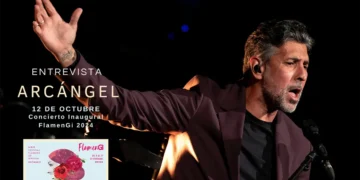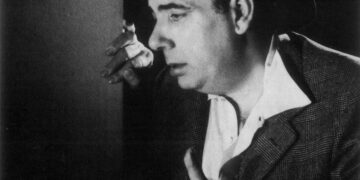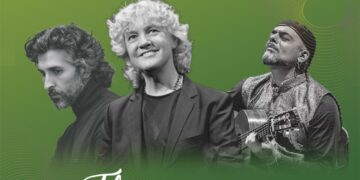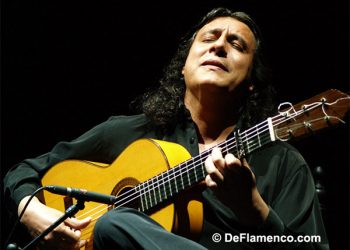|
|
||||||||
|
SPECIAL COVERAGE: BIENAL DE FLAMENCO DE SEVILLA 2010 “F2” ARCÁNGEL, JOSÉ ANTONIO RODRÍGUEZ Text: Estela Zatania Cante: Arcángel. Guitarra: José Antonio Rodríguez. Guest artist: Antonio Canales. Second guitarist: Chico Gallardo. Percussion: Agustín Diassera. Double bass: Pedro Vinagre. Chorus and palmas: Los Mellis. With the recession causing cutbacks in so many budgets this year, it seems like a practical idea to bring two stars together, each with his own name, and each of whom on his own, in more prosperous times, would have managed to fill the 1800 seats of the Teatro de la Maestranza. I don’t know whether this is what anyone had in mind when singer Arcángel and flamenco concert guitarist José Antonio Rodríguez joined forces for this show with the very informatic title of “F2” Slightly more than one decade separates Arcángel of Huelva from Rodríguez of Córdoba, but flamenco-wise, they come from the same generation, the first which developed completely during the best years of Camarón and Paco de Lucía, without being imitators of either. In other words, more than taking direct inspiration from the dynamic duo, they took advantage of the artistic freedom and open attitude the pair set in motion in the nineteen-eighties when last night’s central figures were in their formative years. “F2“ is the well-conceived collaboration of two artists with a compatible vision. When the curtain goes up, we see the seven members of the group sitting in a row, and gaudy white polkadots painted on the red background of one of the cajons seems to mock the intended austerity of the setting. The guitar sends out innocent measures of three that lead up to the energy of bulerías, and the singer’s voice delivers soleá apolá with a verse that makes quite a bit about the “cantes of Charamusco”. The refreshing guitar of Rodríguez plays a long introduction for guest artist Antonio Canales, now quite the patriarch. Anyone willing can still find magic in Canales’ dancing, the unmistakable spark of flamenco, although it appears most of the audience isn’t up to the task. The compás of bulería por soleá affords the chance to pull off a few brilliant moves that bring memories of a time when the genre was less globalized and house-broken. When this happens, all the smoke machines, whispered choruses and contemporary harmonies fade into the background. The incredible technique, sweetness and agile voice of Arcángel are ideal for guajiras that remind you of Valderrama in these cantes, and then the artists stand up to form a classic circle for bulerías without guitar, but there is little spontaneity. Canales wraps it up with his dancing, the energy of flamenco is suddenly flowing and this time the audience offers no resistance. A guitar solo of taranta presents a wise mix of classic and contemporary references, but after an hour and a quarter with no change of mood, and the tireless quest for the suave and elegant, the relentless high register of Arcángel and the repetitive choruses, the whole thing begins to wear very thin. Canales arrives to the rescue with his danced impertinences, while the polkadot cajón continues to be amused at all the pretense of sophistication. Arcángel rewards us with his fandangos, and in the darkness of the theater I try to decipher why these cantes sound so good in his voice, when the rest come off like pop songs and transmit a floating, cold, distant quality. Obviously the music one grew up with always has more dimension and meaning, but in Arcángel the separation is extreme.
“ALGO” CONCHA JAREÑO Text: Estela Zatania Dance: Concha Jareño. Guitar: Juan Antonio Suárez ‘Cano’. Gema Caballero, Pedro Obregón. Violin: Raúl Márquez. Percussion: Luis Amador. Director and choreography: Concha Jareño. Concha Jareño is of today’s best-prepared and versatile professionals of Spanish dance. In Córdoba she was given important prizes for her decidedly retro dancing, but most of her later work is rigorously contemporary and experimental. And she manages both extremes exceedingly well. “Algo” is a strongly avant-garde conceptual proposition with few concessions to flamenco. Flowing materials, the sound of a harpsichord, techno music, a whole menu of unusual or surreal references. The voice of Gema Caballero, so lackluster just a few days ago in “Cuando las Piedras Vuelan”, in this work goes far beyond the mere decoration normally provided by sweet lyrical voices. She surprised many of us with the intensity of her tonás, and she received an especially enthusiastic applause in the final bows. This woman, this is the person who knows who to turn sweetness into pain, because sweetness has the power to trigger tears, and Gema knows the secret. Is she a possibility for this year’s prize for the best young hopeful? It wouldn’t surprise me. This kind of conceptual dance is tough going for flamenco fans used to another kind of show. The title doesn’t lie: “Algo”, ‘anything’ is what is offered, and you can’t quite say what it’s about, but it doesn’t feel like flamenco despite the abundance of footwork, bata de cola, fan, flowers and other accessories. Guitarist Cano, standing alone in the middle of the stage with a wireless mike on his guitar – this is already a declaration of sorts – played a long rambling composition that sounded like a half-hearted improvisation. The contemplative introductions Paco de Lucía introduced for bulerías and tangos and which are the calm before the storm, here remain as one long continuous introduction, because the flamenco moment never quite arrives, and it’s no longer silence charged with expectation, but merely silence. Abandolao, a little jaleo extremeño, Camarón’s “Canastera” possibly danced for the first time, a long bulería danced to compás without voice or guitar, siguiriya inspired not in the cante but the compás… Concha’s excellent dancing and her expressive face are the elements that most light up what is otherwise a somewhat listless work. I long for Concha Jareño to dance to the forms of flamenco singing that identify the genre. And I want Rocío Molina to do the same. And others I could mention, but just talking about what we’ve seen within the Bienal so far. I dearly wish flamenco would awaken from its long siesta, recuperate its innate intensity and once again move audiences with its power and life. |


































